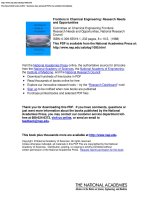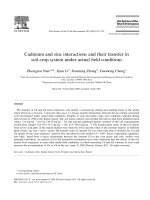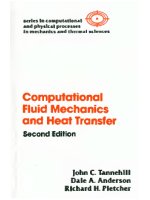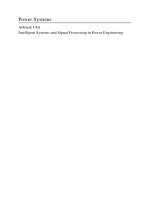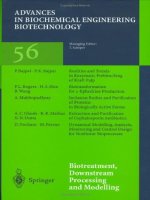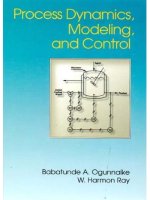hydrodynamics, mass, and heat transfer in chemical engineering, crc (2002) - opet
Bạn đang xem bản rút gọn của tài liệu. Xem và tải ngay bản đầy đủ của tài liệu tại đây (19.74 MB, 406 trang )
HYDRODYNAMICS, MASS AND
HEAT TRANSFER IN CHEMICAL
ENGINEERING
Topics in Chemical Engineering
A
series edited by
R.
Hughes, University of Salford,
UK
Volume
1
Volume
2
Volume
3
Volume
4
Volume
5
Volume
6
Volume
7
Volume
8
Volume
9
Volume
10
Volume
11
HEAT AND MASS TRANSFER
W
PACKED BEDS
by N. Wakao and S. Kaguei
THREE-PHASE CATALYTIC REACTORS
by P.A. Ramachandran and R.V. Chaudhari
DRYING: Principles, Applications and Design
by C. Strumillo and T. Kudra
THE ANALYSIS OF CHEMICALLY REACTING
SYSTEMS: A Stochastic Approach
by L.K. Doraiswamy and B.K. Kulkarni
CONTROL OF LIQUID-LIQUID EXTRACTION COLUMNS
by K. Najim
CHEMICAL ENGINEERING DESIGN PROJECT:
A Case Study Approach
by M.S. Ray and D.W. Johnston
MODELLING, SIMULATION AND OPTIMIZATION OF
INDUSTRIAL FIXED BED CATALYTIC REACTORS
by S.S.E.H. Elnashaie and S.S. Elshishini
THREE-PHASE SPARGED REACTORS
edited by K.D.P. Nigam and A. Schumpe
DYNAMIC MODELLING, BIFURCATION AND CHAOTIC
BEHAVIOUR OF GAS-SOLID CATALYTIC REACTORS
by S.S.E.H. Elnashaie and SS. Elshishini
THERMAL PROCESSING OF BIO-MATERIALS
edited by T. Kudra and C. Strurnillo
COMPOSITION MODULATION OF CATALYTIC
REACTORS
by P.L. Silveston
Please see the back of this book for other titles in the Topics in Chemical
Engineering series.
HYDRODYNAMICS, MASS AND
HEAT TRANSFER IN CHEMICAL
ENGINEERING
A.D. Polyanin
lnstitute for Problems in Mechanics, Moscow, Russia
A.M. Kutepov
Moscow State Academy of Chemical Engineering, Moscow, Russia
A.V. Vyazm in
Karpov lnstitute of Physical Chemistry, Moscow, Russia
D.A. Kazenin
Moscow State Academy of Chemical Engineering, Moscow, Russia
CRC PRESS
Boca Raton London
New
York Washington,
D.C.
First published 2002 by Taylor
&
Francis
11 New Fetter Lane, London EC4P
4EE
Simultaneously published in the USA and Canada
by Taylor
&
Francis Inc.
29 West 35th Street, New York, NY 10001
Taylor
&
Francis is an imprint of the Taylor
&
Francis Group
O
2002 Taylor
&
Francis
This book has been produced from camera-ready copy
supplied by the authors
Printed and bound in Great Britain by
MPG Books Ltd, Bodmin
All rights reserved. No part of this book may be reprinted or
reproduced or utilised in any form or by any electronic,
mechanical, or other means, now known or hereafter invented,
including photocopying and recording, or in any information
storage or retrieval system, without permission in writing from
the publishers.
Every effort has been made to ensure that the advice and information
in this book is true and accurate at the time of going to press.
However, neither the publisher nor the authors can accept any legal
responsibility or liability for any errors or omissions that may be made.
In
the case of drug administration, any medical procedure or the use
of technical equipment mentioned within this book, you are strongly
advised to consult the manufacturer's guidelines.
British Library Cataloguing in Publication Data
A catalogue record for this book is available from the British Library
Library of Congress Cataloging in Publication Data
A
catalog record for this book has been requested
ISBN 0-415-27237-8
CONTENTS
Introduction to the Series
Preface
Basic Notation
xiii
xv
xvii
1
.
Fluid Flows in Films. Jets. nbes. and Boundary Layers
1.1. Hydrodynamic Equations and Boundary Conditions
.
1.1- 1
.
Laminar Flows Navier-Stokes Equations
1.1-2. Initial Conditions and the Simplest Boundary Conditions
1.1-3. Translational and Shear Flows
1.1-4. Turbulent Flows
1.2. Flows Caused by a Rotating Disk
1.2-1. Infinite Plane Disk
1.2-2. Disk of Finite Radius
1.3. Hydrodynamics of Thin Films
.
1 .3-1 Preliminary Remarks
1.3-2. Film on an Inclined Plane
1.3-3. Film on a Cylindrical Surface
1.3-4. Two-Layer Film
1.4. JetFlows
1 .4-1
.
Axisymmetric Jets
1.4-2. Plane Jets
1.4-3. Structure of Wakes Behind Moving Bodies
1.5. Laminar Flows in Tubes
1.5-1. Statement of the Problem
1.5-2. Plane Channel
1.5-3. Circular Tube
1.5-4. Tube of Elliptic Cross-Section
1.5-5. Tube of Rectangular Cross-Section
1.5-6. Tube of Triangular Cross-Section
1.5-7. Tube of Arbitrary Cross-Section
1.6. Turbulent Flows in Tubes
1.6-1. Tangential Stress
.
Turbulent Viscosity
1.6.2. Structure of the Flow
.
Velocity Profile in a Circular Tube
1.6-3. Drag Coefficient of a Circular Tube
1.6-4. Turbulent Flow in a Plane Channel
1.6-5. Drag Coefficient for Tubes of Other Shape
1.7. Hydrodynamic Boundary Layer on a Flat Plate
1.7- 1
.
Preliminary Remarks
1.7-2. Laminar Boundary Layer
1.7-3. Turbulent Boundary Layer
1.8. Gradient Boundary Layers
1.8-1. Equations and Boundary Conditions
1.8-2. Boundary Layer on a V-Shaped Body
1.8.3. Qualitative Features of Boundary Layer Separation
l
.
9.
Transient and Pulsating Flows
1.9-1. Transient or Oscillatory Motion of an Infinite Flat Plate
1.9-2. Transient or Pulsating Flows in Tubes
1.9-3. Transient Rotational Fluid Motion
2
.
Motion of Particles. Drops. and Bubbles in Fluid
2.1. Exact Solutions of the Stokes Equations
.
.
2.1 1 Stokes Equations
2.1-2. General Solution for the Axisymmetric Case
2.2.
Spherical Particles. Drops. and Bubbles in Translational Stokes Flow
2.2-1. Flow Past
a
Spherical Particle
2.2-2. Flow Past a Spherical Drop or Bubble
2.2-3. Steady-State Motion of Particles and Drops in a Fluid
2.2-4. Flow Past Drops With a Membrane Phase
2.2-5. Flow Past a Porous Spherical Particle
2.3.
Spherical Particles in Translational Flow at Various Reynolds Numbers
2.3-1. Oseen's and Higher Approximations as
Re
+
0
2.3-2. Flow Past Spherical Particles in a Wide Range of
Re
2.3-3. Formulas for Drag Coefficient in a Wide Range of
Re
2.4. Spherical Drops and Bubbles in Translational Flow at Various Reynolds
Numbers
2.4-1. Bubble in a Translational Flow
2.4-2. Drop in a Translational Liquid Flow
2.4-3. Drop in a Translational Gas Flow
2.4-4. Dynamics of
an
Extending (Contracting) Spherical Bubble
2.5. Spherical Particles. Drops. and Bubbles in Shear Flows
2.5-1. Axisymmetric Straining Shear Flow
2.5-2. Three-Dimensional Shear Flows
2.6. Flow Past Nonspherical Particles
2.6-1. Translational Stokes Flow Past Ellipsoidal Particles
2.6-2. Translational Stokes Flow Past Bodies of Revolution
2.6-3. Translational Stokes Flow Past Particles of Arbitrary Shape
2.6-4. Sedimentation of Isotropic Particles
2.6-5. Sedimentation of Nonisotropic Particles
2.6-6. Mean Velocity of Nonisotropic Particles Falling in a Fluid
2.6-7. Flow Past Nonspherical Particles at Higher Reynolds Numbers
2.7. Flow Past a Cylinder (the Plane Problem)
2.7-1. Translational Flow Past a Cylinder
2.7-2. Shear Flow Around a Circular Cylinder
2.8. Flow Past Deformed Drops and Bubbles
2.8-1. Weak Deformations of Drops at Low Reynolds Numbers
2.8-2. Rise of an Ellipsoidal Bubble at High Reynolds Numbers
2.8-3. Rise of a Large Bubble of Spherical Segment Shape
vii
2.8-4. Drops Moving in Gas at High Reynolds Numbers
2.9. Constrained Motion of Particles
2.9- 1
.
Motion of Two Spheres
2.9-2. Gravitational Sedimentation of Several Spheres
2.9-3. Wall Influence on the Sedimentation of Particles
2.9-4. Particle on the Interface Between Two Fluids
2.9.5. Rate of Suspension Precipitation
.
The Cellular Model
2.9.6. Effective Viscosity of Suspensions
3
.
Mass and Heat Transfer in Liquid Films. Tubes. and Boundary Layers
. .
3.1.
Convective Mass and Heat Transfer
.
Equations and Boundary Conditions
.
.
3.1-1. Mass Transfer Equation Laminar Flows
3.1-2. Initial Condition and the Simplest Boundary Conditions
3.1-3. Mass Transfer Complicated by a Surface Chemical Reaction
3.1-4. Mass Transfer Complicated by a Volume Chemical Reaction
3.1-5. Diffusion Fluxes and the Sherwood Number
.
3.1.6. Heat Transfer The Equation and Boundary Conditions
3.1-7. Some Methods of Theory of Mass and Heat Transfer
3.1-8. Mass and Heat Transfer in Turbulent Flows
3.2. Diffusion to a Rotating Disk
.
3.2. 1 Infinite Plane Disk
3.2-2. Disk of Finite Radius
3.3. Heat Transfer to a Flat Plate
.
3.3- 1 Heat Transfer in Laminar Flow
3.3-2. Heat Transfer in Turbulent Flow
3.4. Mass Transfer in Liquid Films
3.4-1. Mass Exchange Between Gases and Liquid Films
3.4-2. Dissolution of a Plate by a Laminar Liquid Film
3.5. Heat and Mass Transfer in a Laminar Flow in a Circular Tube
3.5-1. Tube with Constant Temperature of the Wall
3.5-2. Tube with Constant Heat Flux at the Wall
3.6. Heat and Mass Transfer in a Laminar Flow in a Plane Channel
3.6-1. Channel with Constant Temperature of the Wall
3.6-2. Channel with Constant Heat Flux at the Wall
3.7. Turbulent Heat Transfer in Circular Tube and Plane Channel
.
3.7-
1
Temperature Profile
3.7-2. Nusselt Number for the Thermal Stabilized Region
3.7-3. Intermediate Domain and the Entry Region of the Tube
3.8. Limit Nusselt Numbers for Tubes of Various Cross-Sections
3.8-1. Laminar Flows
3.8-2. Turbulent Flows
4
.
Mass and Heat Exchange Between Flow and Particles. Drops. or Bubbles
4.1. The Method of Asymptotic Analogies in Theory of Mass and Heat Transfer
.
.
4.1 1 Preliminary Remarks
4.1-2. Transition to Asymptotic Coordinates
4.1.3. Description of the Method
viii
CONTENTS
4.2. Interiors Heat Exchange Problems for Bodies of Various Shapes
4.2-1. Statement of the Problem
4.2-2. General Formulas for the Bulk Temperature of the Body
4.2-3. Bulk Temperature for Bodies of Various Shapes
4.3. Mass and Heat Exchange Between Particles of Various Shapes and a Stagnant
Medium
4.3-1. Stationary Mass and Heat Exchange
4.3-2. Transient Mass and Heat Exchange
4.4. Mass Transfer in Translational Flow at Low Peclet Numbers
4.4-1. Statement of the Problem
4.4-2. Spherical Particle
4.4-3. Particle of an Arbitrary Shape
4.4.4. Cylindrical Bodies
4.5. Mass Transfer in Linear Shear Flows at Low Peclet Numbers
4.5-1. Spherical Particle in a Linear Shear Flow
4.5-2. Particle of Arbitrary Shape in a Linear Shear Flow
4.5-3. Circular Cylinder in a Simple Shear Flow
4.6. Mass Exchange Between Particles or Drops and Flow at High Peclet Numbers
4.6-1. Diffusion Boundary Layer Near the Surface of a Particle
4.6-2. Diffusion Boundary Layer Near the Surface of a Drop (Bubble)
4.6.3. General Formulas for Diffusion Fluxes
4.7.
Particles, Drops, and Bubbles in Translational Flow
.
Various Peclet and
Reynolds Numbers
4.7- 1
.
Mass Transfer at Low Reynolds Numbers
4.7-2. Mass Transfer at Moderate and High Reynolds Numbers
4.7-3. General Correlations for the Sherwood Number
4.8. Particles, Drops, and Bubbles in Linear Shear Flows
.
Arbitrary Peclet
Numbers
4.8-1. Linear Straining Shear Flow
.
High Peclet Numbers
4.8-2. Linear Straining Shear Flow
.
Arbitrary Peclet Numbers
4.8-3. Simple Shear and Arbitrary Plane Shear Flows
4.9.
Mass Transfer in a Translational-Shear Flow and in a Flow with Parabolic
Profile
4.9-1. Diffusion to a Sphere in a Translational-Shear Flow
4.9-2. Diffusion to a Sphere in a Flow with Parabolic Profile
4.10. Mass Transfer Between Nonspherical Particles or Bubbles
and
Translational
Flow
4.10-1. Ellipsoidal Particle
4.10-2. Circular Thin Disk
4.10.3. Particles of Arbitrary Shape
4.10-4. Deformed Gas Bubble
4.11. Mass and Heat Transfer Between Cylinders and Translational or Shear Flows
4.1 1-1
.
Diffusion to a Circular Cylinder in a Translational Flow
4.1 1-2
.
Diffusion to a Circular Cylinder in Shear Flows
4.1 1-3
.
Heat Exchange Between Cylindrical Bodies and Liquid Metals
4.12. Transient Mass Transfer in Steady-State Translational and Shear Flows
197
4.12-1. Statement of the Problem 197
4.12-2. Spherical Particles and Drops at High Peclet Numbers
198
4.13-3. Spherical Particles and Drops at Arbitrary Peclet Numbers
199
4.12-4. Nonspherical Particles, Drops, and Bubbles
200
4.13. Qualitative Features of Mass Transfer Inside a Drop at High Peclet Numbers
201
4.13-1. Limiting Diffusion Resistance of the Disperse Phase
201
4.13-2. Comparable Diffusion Phase Resistances
205
4.14. Diffusion Wake
.
Mass Exchange of Liquid with Particles or Drops Arranged
inLines
206
4.14-1. Diffusion Wake at High Peclet Numbers
206
4.14-2. Diffusion Interaction of Two Particles or Drops
207
4.14-3. Chains of Particles or Drops at High Peclet Numbers
209
4.15. Mass and Heat Transfer Under Constrained Flow Past Particles, Drops, or
Bubbles
211
4.15-1. Monodisperse Systems of Spherical Particles
211
4.15-2. Polydisperse Systems of Spherical Particles
212
4.15-3. Monodisperse Systems of Spherical Drops or Bubbles
213
4.15-4. Packets of Circular Cylinders
214
5
.
Mass and Heat 'Ikansfer Under Complicating Factors
215
Mass Transfer Complicated by a Surface Chemical Reaction
5.1-1. Particles. Drops. and Bubbles
5.1-2. Rotating Disk and a Flat Plate
5.1-3. Circular Tube
Diffusion to a Rotating Disk and a Flat Plate Complicated by a Volume
Reaction
5.2-1. Mass Transfer to the Surface of a Disk Rotating in a Fluid
5.2-2. Mass Transfer to a Flat Plate in a Translational Flow
Mass Transfer Between Particles, Drops, or Bubbles and Flows, with Volume
Reaction
5.3-1. Statement of the Problem
5.3-2. Particles in a Stagnant Medium
.
5.3.3. Particles, Drops, and Bubbles First-Order Reaction
.
5.3.4. Particles, Drops, and Bubbles Arbitrary Rate of Reaction
Mass Transfer Inside a Drop (Cavity) Complicated by a Volume Reaction
.
5.4-1. Spherical Cavity Filled by a Stagnant Medium
5.4-2. Nonspherical Cavity Filled by a Stagnant Medium
5.4-3. Convective Mass Transfer Within a Drop (Cavity)
Transient Mass Transfer Complicated by Volume Reactions
5.5.1. Statement of the Problem
5.5-2. Irreversible First-Order Reaction
5.5-3. Irreversible Reactions with Nonlinear Kinetics
5.5.4. Reversible First-Order Reaction
230
X
CONTENTS
5.6. Mass Transfer for an Arbitrary Dependence of the Diffusion Coefficient on
Concentration
5.6-1. Preliminary Remarks
.
Statement of the Problem
5.6-2. Steady-State Problems, Particles. Drops. and Bubbles
5.6-3. Transient Problems
.
Particles. Drops. and Bubbles
5.7. Film Condensation
5.7-1. Statement of the Problem
5.7-2. Equation for the Thickness of the Film
.
Nusselt Solution
5.7-3. Some Generalizations
5.8. Nonisothermal Flows in Channels and Tubes
.
5.8-1. Heat Transfer in Channel Account of Dissipation
.
5.8-2. Heat Transfer in Circular Tube Account of Dissipation
5.8-3. Qualitative Features of Heat Transfer in Highly Viscous Liquids
5.8-4. Nonisothermal Turbulent Flows in Tubes
5.9.
Thermogravitational and Thermocapillary Convection in a Fluid Layer
5.9-1. Thermogravitational Convection
5.9-2. Joint Thermocapillary and Thermogravitational Convection
.
5.9-3. Thermocapillary Motion Nonlinear Problems
5.10. Thermocapillary Drift of a Drop
5.10-1. Drift of a Drop in a Fluid with Temperature Gradient
5.10-2. Drift of a Drop in Complicated Cases
5.10-3. General Formulas for Capillary Force and Drift Velocity
5.11. Chemocapillary Effect in the Drop Motion
.
5.11-1. Preliminary Remarks Statement of the Problem
5.11-2. Drag Force and Velocity of Motion
6
.
Hydrodynamics and Mass and Heat Transfer in Non-Newtonian Fluids
.
6.1.
Rheological Models of Non-Newtonian Incompressible Fluids
6.1-1. Newtonian Fluids
6.1-2. Nonlinearly Viscous Fluids
6.1-3. Power-Law Fluids
6.1-4. Reiner-Rivlin Media
6.1-5. Viscoplastic Media
6.1-6. Viscoelastic Fluids
6.2. Motion of Non-Newtonian Fluid Films
.
6.2-1. Statement of the Problem Formula for the Friction Stress
.
6.2-2. Nonlinearly Viscous Fluids Power-Law Fluids
.
6.2-3. Viscoplastic Media The Shvedov-Bingham Fluid
6.3. Mass Transfer in Films of Rheologically Complex Fluids
6.3-1. Mass Exchange Between a Film and a Gas
6.3-2. Dissolution of a Plate by a Fluid Film
6.4. Motion of Non-Newtonian Fluids in Tubes and Channels
.
6.4-1. Circular Tube Formula for the Friction Stress
.
6.4-2. Circular Tube Nonlinearly Viscous Fluids
.
6.4-3. Circular Tube Viscoplastic Media
6.4-4. Plane Channel
.
Heat Transfer in Channels and Tubes Account of Dissipation
.
6.5. 1 Plane Channel
6.5-2. Circular Tube
Hydrodynamic Thermal Explosion in Non-Newtonian Fluids
.
6.6.1. Nonisothermal Flows Temperature Equation
.
6.6.2. Exact Solutions Critical conditions
Hydrodynamic and Diffusion Boundary Layers in Power-Law Fluids
6.7-1. Hydrodynamic Boundary Layer on a Flat Plate
6.7-2. Hydrodynamic Boundary Layer on a V-Shaped Body
6.7-3. Diffusion Boundary Layer on a Flat Plate
Submerged Jet of a Power-Law Fluid
6.8-1. Statement of the Problem
6.8-2. Exact Solutions
6.8-3. Jet Width and Volume Rate of Flow
Motion and Mass Exchange of Particles, Drops, and Bubbles in
Non-Newtonian Fluids
6.9- 1
.
Drag Coefficients
6.9-2. Sherwood Numbers
6.10. Transient and Oscillatory Motion of Non-Newtonian Fluids
296
6.10-1. Transient Motion of an Infinite Flat Plate
296
6.10-2. Oscillating Flat-Plate Flow for Maxwellian Fluids
299
6.10-3. Transient Simple Shear Flow of Shvedov-Bingham Fluids 299
7
.
Foams: Structure and Some Properties
301
.
Fundamental Parameters Models of Foams 302
7.1.1. Multiplicity, Dispersity. and Polydispersity of Foams 302
7.1-2. Capillary Pressure and Capillary Rarefaction 304
7.1-3. The Polyhedral Model of Foams
305
Envelope of Foam Cells
308
7.2-1. Capsulated Structure of Foam Cells
308
7.2.2. Elasticity of the Solution Surface
309
7.2.3. Elasticity of Foam Cell Elements
312
Kinetics of Surfactant Adsorption in Liquid Solutions
312
7.3.1. Mass Transfer Problems for Surfactants
312
7.3.2. Kinetics of Surfactant Adsorption in Foam Films
313
7.3.3. Kinetics of Surfactant Adsorption in a Transient Foam Body
314
Internal Hydrodynamics of Foams
.
Syneresis and Stability
315
7.4-1. Internal Hydrodynamics of Foams
316
7.4-2. Generalized Equation of Syneresis
317
7.4.3. Gravitational and Centrifugal Syneresis
318
7.4-4. Barosyneresis
319
7.4.5. Stability, Evolution, and Rupture of Foams
320
Rheological Properties of Foams
322
7.5. 1
.
Macrorheological Models of Foams
322
7.5.2. Shear Modulus, Effective Viscosity, and Yield Stress
323
7.5.3. Other Approaches and Problems
325
xii
CONTENTS
Supplements
S.1. Exact Solutions of Linear Heat and Mass Transfer Equations
S
.
1 -l
.
Heat Equation
S.1-2. Heat Equation with a Source
S
.
1-3
.
Heat Equation in the Cylindrical Coordinates
S
.
1-4
.
Heat Equation in Spherical Coordinates
S.2. Formulas for Constructing Exact Solutions
S.2-1. Duhamel Integrals
S.2-2. Problems with Volume Reaction
S.3. Orthogonal Curvilinear Coordinates
S.3-1. Arbitrary Orthogonal Coordinates
S.3-2. Cylindrical Coordinates
R,
p,
Z
S.3-3. Spherical Coordinates
R,
0,
cp
S.3-4. Coordinates of a Prolate Ellipsoid of Revolution
a,
r,
cp
S.3-5. Coordinates of an Oblate Ellipsoid of Revolution
a,
r,
cp
S.3-6. Coordinates of an Elliptic Cylinder
a,
r,
Z
S.4. Convective Diffusion Equation in Miscellaneous Coordinate Systems
S.4-1. Diffusion Equation in Cylindrical and Spherical Coordinates
S.4-2. Diffusion Equation in Arbitrary Orthogonal Coordinates
SS
.
Equations of Fluid Motion in Miscellaneous Coordinate Systems
SS-1
.
Navier-Stokes Equations in Cylindrical Coordinates
SS-2
.
Navier-Stokes Equations in Spherical Coordinates
S.6. Equations of Motion and Heat Transfer of Non-Newtonian Fluids
S.6- 1
.
Equations in Rectangular Cartesian Coordinates
S.6-2. Equations in Cylindrical Coordinates
S.6-3. Equations in Spherical Coordinates
References
Index
Introduction to the Series
The subject matter of chemical engineering covers a very wide spectrum of
learning and the number of subject areas encompassed in both undergraduate
and graduate courses is inevitably increasing each year. This wide variety of
subjects makes it difficult to cover the whole subject matter of chemical
engineering in a single book. The present series is therefore planned as a
number of books covering areas of chemical engineering which, although
important, are not treated at any length in graduate and postgraduate standard
texts. Additionally, the series will incorporate recent research material which
has reached the stage where an overall survey is appropriate, and where
sufficient information is available to merit publication in book form for the
benefit of the profession as a whole.
Inevitably, with a series such as this, constant revision is necessary if the
value of the texts for both teaching and research purposes is to be maintained.
I
would be grateful to individuals for criticisms and for suggestions for future
editions.
R.
HUGHES
.
.
.
Xlll
Preface
The book contains a concise and systematic exposition of fundamental problems
of hydrodynamics, heat and mass transfer, and physicochemical hydrodynamics,
which constitute the theoretical basis of chemical engineering science.
In the selection of the material, the authors have given preference to simple
exact, approximate, and empirical formulas that can be used in a wide range of
practical applications.
A
number of new formulas are presented. Special atten-
tion has been paid to universal formulas that can be used to describe entire
classes of problems (that differ in geometric or other factors). Such formulas
provide a lot of information in compact form.
Each section of the book usually begins with a brief physical and mathemati-
cal statement of the problem considered. Then final results are usually given for
the desired variables in the form of final relationships and tables (as a rule, the
solution method is not presented, only some explanations and necessary refer-
ences are given). This approach simplifies the understanding of the text for a
wider readership.
Only the most important problems that admit exact analytical solution are
discussed in more detail. Such solutions play an important role in the proper
understanding of qualitative features of many phenomena and processes in vari-
ous areas of natural and engineering sciences. The corresponding sections of the
book may be used by college and university lecturers of courses in chemical
engineering science, hydrodynamics, heat and mass transfer, and
physicochemi-
cal hydrodynamics for graduate and postgraduate students.
In Chapters
1
and
2
we study fluid flows, which underlie numerous processes
of chemical engineering science. We present up-to-date results about transla-
tional and shear flows past particles, drops, and bubbles of various shapes at a
wide range of Reynolds numbers. Single particles and systems of particles are
considered. Film and jet flows, fluid flows through tubes and channels of various
shapes, and flow past plates, cylinders, and disks are examined.
In Chapters
3
and
4
we analyze mass and heat transfer in plane channels,
tubes, and fluid films. We consider the mass and heat exchange between parti-
cles, drops, or bubbles and uniform or shear flows at various Peclet and Reynolds
numbers. The results presented are of great importance in obtaining scientifi-
cally justified methods for a number of technological processes such as dissolu-
tion, drying, adsorption, aerosol and colloid sedimentation, heterogeneous catalytic
reactions, absorption, extraction, and rectification.
In Chapter
5
some problems of mass and heat transfer with various complic-
ating factors are discussed. Mass transfer problems are investigated for various
xvi
PREFACE
kinetics of volume and surface chemical reactions. Nonlinear problems of con-
vective mass and heat exchange are considered taking into account the depend-
ence of the transfer coefficients on concentration (temperature). Nonisothermal
flows through tubes and channels accompanied by dissipative heating of liquid
are also studied. Qualitative features of heat transfer in liquids with temperature-
dependent viscosity are discussed, and various thermohydrodynamic phenom-
ena related to the fact that the surface tension coefficient is temperature dependent
are analyzed.
In Chapter
6
we consider problems of hydrodynamics and mass and heat
transfer in non-Newtonian fluids and describe the basic models for rheologically
complicated fluids, which are used in chemical technology. Namely, we consider
the motion and mass exchange of power-law and viscoplastic fluids through
tubes, channels, and films. The flow past particles, drops, and bubbles in non-
Newtonian fluid are also analyzed.
Chapter
7
deals with the basic concepts and properties of very specific tech-
nological media, namely, foam systems. Important processes such as surfactant
interface accumulation, syneresis, and foam rupture are considered.
The supplements contain tables with exact solutions of the heat equation. In
addition, the equation of convective diffusion, the continuity equation, equations
of motion in some curvilinear orthogonal coordinate systems, and some other
reference materials are given.
The topics in the present book are arranged in increasing order of difficulty,
which substantially simplifies understanding the material.
A
detailed table of
contents readily allows the reader to find the desired information.
A
lot of
material and its compact presentation permit the book to be used as a concise
handbook in chemical engineering science and related fields in hydrodynamics,
heat and mass transfer, etc.
The authors are grateful to
A.
E.
Rednikov and Yu.
S.
Ryazantsev, who wrote
Sections
5.8-5.10,
Z.
D.
Zapryanov, who contributed to Sections 1.2,
1.3,
and
2.9,
and
A.
G.
Petrov, who contributed to Subsections 2.4-3,2.8-2, and 2.8-4. We
express our deep gratitude to
V.
E.
Nazaikinskii and
A.
I. Zhurov for fruitful
discussions and valuable remarks.
The work on this book was supported in part by the Russian Foundation for
Basic Research.
The authors hope that the book will be useful for researchers and engineers,
as well as postgraduate and graduate students, in chemical engineering science,
hydrodynamics, heat and mass transfer, mechanics of disperse systems, physico-
chemical hydrodynamics, power engineering, meteorology, and biomechanics.
Basic Notation
Latin
Symbols
characteristic scale of length; radius of spherical particle or circular
cylinder
radius of volume-equivalent sphere
radius of perimeter-equivalent sphere (for body of revolution)
concentration
nonperturbed concentration (in incoming flow remote from particle)
concentration at surface of particle (or tube)
dimensionless concentration (introduced differently in various problems,
see Table 3.1 in Section 3.1)
drag coefficient (for particles, drops, and bubbles); local coefficient of
friction
specific heat at constant pressure
diffusion coefficient
turbulent diffusion coefficient
diameter of circular tube, spherical particle, or circular cylinder
equivalent diameter
shear rate tensor components
viscous drag forces acting on particle, drop or bubbles
drag forces of body of revolution for its parallel and perpendicular posi-
tions in translational flow
thermocapillary force acting on drop
kinetic function of surface reaction,
F,
=
Fs(C)
kinetic function of volume reaction,
F,
=
Fv(C)
Froude number
dimensionless kinetic function of surface reaction,
fs
=
fs(c)
dimensionless kinetic function of volume reaction,
fv
=
f,(c)
mean value of dimensionless kinetic function,
(f,)
=
A:
f,(c) dc
shear matrix coefficients
Grashof number
acceleration due to gravity
metric tensor components
film thickness; half-width of plane channel
dimensionless total diffusion flux
total diffusion flux
dimensionless total heat flux
unit vectors of Cartesian coordinate system
momentum of jet
dimensionless diffusion flux
diffusion flux
xviii
BASIC
N~TATION
dimensionless heat flux
rate constant for surface chemical reaction
rate constant for volume chemical reaction
Kutateladze number
consistence factor of power-law fluid
dimensionless rate constant for surface chemical reaction
dimensionless rate constant for volume chemical reaction
Lewis number
Marangoni number
Morton number
Nusselt number; mean Nusselt number
local Nusselt number
limit Nusselt number
rate order of chemical reaction (surface or volume) or rheological para-
meter of power-law fluid
pressure
nonperturbed pressure remote from particle (drop or bubble)
diffusion Peclet number,
Pe
=
aU/D
heat Peclet number
turbulent Prandtl number
volume rate of flow (through tube cross-section)
spherical coordinate system,
R
=
\/x2
+
YZ
+
Z2
cylindrical coordinate system,
R
=
m
Reynolds number,
Re
=
aU/u
Reynolds number based on diameter,
Red
=
dU/v
local Reynolds number,
Rex
=
XU/u
dimensionless radial spherical coordinate,
r
=
R/a
dimensionless area of surface,
S
=
S,/a2
dimensional area of surface
Schmidt number,
Sc
=
u/D
mean Sherwood number,
Sh
=
I/S
mean Sherwood number for bubble
mean Sherwood number for particle
mean Sherwood number for drop
asymptotic value of mean Sherwood number at small values of character-
istic parameter of problem
asymptotic value of mean Sherwood number at large values of character-
istic parameter of problem
Strouhal number
dimensionless temperature
temperature
nonperturbed temperature (in incoming flow remote from particle)
temperature at surface of particle (or tube)
average component of temperature for turbulent flow
bulk body temperature
mean flow rate temperature
time
BASIC NOTATION
xix
U
U,
urn,
UT
U*
v
(V)
Vx,
VY,
vz
Vx
VR,
VB,
Vp
VR, v., Vp
v$',
vs"'
characteristic flow velocity
nonperturbed fluid velocity (in incoming flow remote from particle)
maximum fluid velocity at surface of film or on tube axis
thermocapillary drift velocity of drop
friction velocity (for turbulent flows),
U,
=
m
fluid velocity vector
mean flow rate velocity,
(V)
=
Q/S,
fluid velocity components in Cartesian coordinate system
average component of velocity in turbulent flow
fluid velocity components in spherical coordinate system
fluid velocity components in cylindrical coordinate system
fluid velocity components in continuous phase (outside drops) in axisym-
metric case
fluid velocity components in disperse phase (inside drops) in axisymmet-
ric case
dimensionless fluid velocity vector
dimensionless fluid velocity components in Cartesian coordinate system
dimensionless fluid velocity components in spherical coordinate system
Weber number,
We
=
a~:~l/o
(a
is surface tension)
Cartesian coordinate system
Cartesian coordinate system,
XI
=
X, X2
=
Y,
X3
=
Z
dimensionless Cartesian coordinate system
Greek Symbols
viscosity ratio,
p
=
p2/p1
Laplace operator
total pressure drop along a tube part of length
L,
AP
>
0
thickness of hydrodynamic boundary layer
thickness of thermal boundary layer
Kronecker delta
friction temperature (for turbulent flows)
angular coordinate
thermal conductivity coefficient
von Karman constant
drag coefficient (for tubes and channels)
eigenvalues
viscosity
plastic viscosity for Shvedov-Bingham fluid
viscosity of continuous phase
viscosity of disperse phase
kinematic viscosity,
V
=
p/p
turbulent viscosity coefficient
shape factor,
IT
=
Sh S, /a;
disjoining pressure
density
density of continuous phase
density of disperse phase
dimensionless cylindrical coordinate,
Q
=
R/a
perimeter-equivalent factor,
S,
l(4.ira;)
friction stress on wall
shear stress tensor components
yield stress (for Shvedov-Bingham fluid)
angular coordinate (polar angle)
volume fraction of disperse phase
thermal diffusivity
stream function
stream function in continuous phase
stream function in disperse phase
dimensionless stream function
Chapter
1
Fluid Flows in Films, Jets, Tubes,
and Boundary Layers
The information on velocity and pressure fields necessary for studying the dis-
tribution and transformation of reactants in reaction equipment can often be
obtained from purely hydrodynamic considerations. The same hydrodynamic
equations describe a vast variety of actual fluid flows depending on numerous
geometric, physical, and mode factors that determine the flow region, type, and
structure. There are various classifications of flows according to their specific
properties, for example, the widely used classification based on the Reynolds
number Re, which is the most significant state-geometric parameter." This clas-
sification distinguishes flows at low Re
[179], at high Re (boundary layers [427]),
and at supercritical Re (turbulent flows [188]) and is methodologically impor-
tant in that it introduces a small parameter (Re or ~e-l), which permits one
to solve nonlinear hydrodynamic problems reliably by using expansions with
respect to that parameter. Although this classification is undoubtedly fruitful
and convenient for those studying hydrodynamic problems mathematically and
numerically, in the present book we focus our attention on the practical needs of
industrial engineers who deal with specific units of equipment where the type of
flow of the reactive medium is virtually predetermined by the design. Accord-
ingly, our treatment of hydrodynamics consists of two chapters. Chapter
1
deals
with flows of extended fluid media interacting with each other or with containing
walls (flows in films, tubes, channels, jets, and boundary layers near a solid
surface). In Chapter 2 we consider the hydrodynamic interaction of particles of
various nature (solid, liquid, or gaseous) with the ambient continuous phase.
1.1.
Hydrodynamic Equations and Boundary
Conditions
In this section we present equations and boundary conditions used in solving
hydrodynamic problems. Their detailed derivation, as well as an analysis of
*
There are some other flow classifications, for example, with respect to specific properties of
the boundary of the flow region: fluid flow with free boundaries
[385], fluid flow with interface
[226,
5011, and flow along a permeable boundary
[524].
This classification also allows one to
describe properties of various flows and suggest methods for studying these flows.
2
FLUID FLOWS
IN
FILMS, TUBES,
AND
JETS
scope, various physical statements and solutions of related problems, and applied
issues can be found, e.g., in the books [26, 126, 260, 276, 427, 440, 5021. We
consider fluids with constant density
p
and dynamic viscosity
p.
1
1.1-1.
Laminar Flows. Navier-Stokes Equations
I
First, laminar flows of fluids are considered. For brevity, in what follows we
often refer to "laminar flows" simply as "flows."
Navier-Stokes equations.
The closed system of equations of motion for a
viscous incompressible Newtonian fluid consists of the continuity equation
and the three Navier-Stokes equations [326,477]
Equations (l.
l.
l) and (1.1.2) are written in an orthogonal Cartesian system
X,
Y,
and
Z
in physical space;
t
is time;
gx, gy,
and
gz
are the mass force (e.g., the
gravity force) density components;
v
=
p/p
is the kinematic viscosity of the fluid.
The three components of the fluid velocity
VX, Vy, VZ,
and the pressure
P
are
the unknowns.
By introducing the fluid velocity vector V
=
ixVx
+
iyVy
+
iZVZ,
where
ix, iy,
and
iz
are the unit vectors of the Cartesian coordinate system, and by
using the symbolic differential operators
one can rewrite system (1.1.1), (1.1.2) in the compact vector form
v.v=o,
(l.
1
.3)
The continuity and Navier-Stokes equations in cylindrical and spherical
coordinate systems are given in Supplement 5.
1.1.
HYDRODYNAMIC
EQUATIONS
AND
BOUNDARY
CONDITIONS
3
Stream
function.
Most of the problems considered in the first two chapters
possess some symmetry properties. In these cases, instead of the fluid velocity
components, it is often convenient to introduce a stream function
9
on the basis of
the continuity equation (1.1.3). Then (1.1.3) is satisfied automatically. Usually,
the stream function is introduced in the following three cases.
1. In plane problems, all variables are independent of the coordinate
Z,
and
the continuity equation (l.
l
.3) becomes
The stream function *(X,
Y)
is introduced by the relations
(l.
l
S)
The continuity equation is satisfied identically.
2.
In axisymmetric problems, all variables are independent of the axial
coordinate
Z
in the cylindrical coordinates
R,
8,
Z.
The continuity equation has
the form (both sides are multiplied by
R)
and the stream function is introduced
by
3. In axisymmetric problems, all variables are independent of the coordi-
nate
cp
in the spherical coordinates R, 8,
cp.
The continuity equation has the form
(both sides are multiplied by R)
1
a
l
d
(R~vR)
+
R dR
(h
sin 8)
=
0,
sin0 d0
and the stream function is introduced by
1
d4
vR=
l
84
vs
=
R2sin8 do
'
(1.1.10)
R sin 8 dR
'
In all these cases, the stream function depends only on two orthogonal
coordinates. The streamlines are determined by the equation
4
=
const. To each
line there corresponds a constant value of the stream function. The fluid velocity
vector is tangent to the streamline. (Note that the streamlines coincide with the
trajectories of fluid particles only in the stationary case.)
4
FLUID FLOWS
IN
FILMS, TUBES,
AND
JETS
Table 1.1 presents equations for the stream function, obtained from the
Navier-Stokes equations (1.1. l), (1.1.2) in various coordinate systems.
Dimensionlessform of equations.
To analyze the hydrodynamic equations
(1.1.3), (1.1.4), it is convenient to introduce dimensionless variables and un-
known functions as follows:
where
a
and
U
are the characteristic length and the characteristic velocity, re-
spectively. As a result, we obtain
dv
1 1
g
-
+
(v.
V)v=-Vp+ -AV+
dt
Re
Fr
g
In
Eq.
(1.1.12), the following basic dimensionless state-geometric parameters of
the flow are used:
aU
.
U2
Re
=
-
is the Reynolds number,
Fr
=
-
is the Froude number.
V
ga
Small values of Reynolds numbers correspond to slow ("creeping") flows and
high Reynolds numbers, to rapid flows. Since these limit cases contain a small
or large dimensionless parameter, one can efficiently use various modifications
of the perturbation method [224,258,485].
(
1.1-2.
Initial Conditions and the Simplest Boundary Conditions
I
For the solution of system (1.1. l), (1.1.2) to determine the velocity and pressure
fields uniquely, we must impose initial and boundary conditions.
In nonstationary problems, where the terms with partial derivatives with
respect to time are retained in the equation of motion, the initial velocity field
must be given in the entire flow region and satisfy the continuity equation
(l.
l. 1)
there. The initial pressure field need not be given, since the equations do not
contain the derivative of pressure with respect to time.*
As a rule, the region occupied by a moving reactive mixture is not the entire
space but only a part bounded by some surfaces. According to whether the
point at infinity belongs to the flow region or not, the problem of finding the
unknown functions is called the exterior or interior problem of hydrodynamics,
respectively.
On the surface
S
of a solid body moving in a flow of a viscous fluid, the
no-slip condition is imposed. This condition says that the vector
Vls
of the fluid
*
Obviously, if
an
arbitrary initial pressure field is given, it may happen that the velocity fields
obtained from the equations of motion do not satisfy the continuity equation fort
>
0
[404].
No such
problems arise in the stationary case.
1.1.
HYDRODYNAMIC
EQUATIONS
AND
BOUNDARY
CONDITIONS
5


